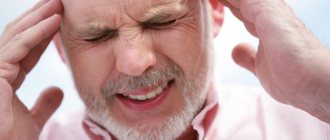Smoking is a serious addiction. When you quit smoking for a long time, a withdrawal syndrome occurs, which is characterized by increased irritability, a craving to smoke a cigarette, changes in the gastrointestinal tract, etc. When you quit smoking, the body begins to experience severe stress, which is called nicotine withdrawal. How long nicotine withdrawal lasts can be determined based on the duration of the habit and psycho-emotional state.
Nicotine withdrawal can cause serious stress to a person
What is withdrawal?
We should start with the concept: what is abstinence? When translated from Latin, this word means “abstinence.” A person refuses to use certain substances that were constantly entering his body before this period.
Withdrawal syndrome is a very important phenomenon, which the psychological help website psymedcare.ru has drawn its attention to. On the one hand, a person is saved from his addiction, which destroys the functionality of his body. On the other hand, withdrawal develops, which can be associated with withdrawal symptoms.
When a person stops taking a certain substance, his body begins to send signals to reduce the substance in him. Because the body is accustomed to receiving a stable dose of a certain substance, it sends a signal through the brain that it needs to replenish its supply of that drug. It is in this state that various mental, vegetative and somatic disorders develop.
Psychologists note that this condition begins to occur after 0.5-4 days after stopping taking drugs, alcohol or nicotine. During this period, a person becomes uncontrollable. After 5-7 days, the “withdrawal” stops, which is due to the body becoming accustomed to the deficiency of a certain substance. However, these days still need to be lived through, which becomes painful not only for the addicted person, but also for those around him.
The most striking symptoms of withdrawal of any kind are hysteria, uncontrollable aggression and the desire to use the “drug”. Hallucinations, delusions, convulsions and other disorders may occur here.
The problem with giving up bad habits is that an addicted person can rarely cope with the period of “withdrawal” on his own. It is very difficult to persuade yourself not to use a substance that brings happiness, peace, and satisfaction.
If you want to help another person get rid of drug, nicotine or alcohol addiction, you should be prepared for failure, which is associated with withdrawal syndrome. In a state of uncontrollable desire to replenish the body with missing substances, a person will not be able to deny himself. This is why alcoholics and drug addicts so often return to their habit within a couple of days.
You can't do this without outside help. It is good if the addicted person himself seeks help from a specialist who knows all the stages of going through withdrawal syndrome and will accompany the client along the entire path. It becomes almost impossible to give up a bad habit on your own, because after 1 day self-control decreases and the person returns to using harmful substances.
Symptoms of lack of nicotine in the body
Nicotine imitates the neurotransmitter acetylcholine because it binds to the same receptors, but, unlike it, does not regulate body functions. This substance helps nerve cells transmit signals to each other. If the production of acetylcholine is ordered, then smoking activates cholinergic neurons in different regions of the brain simultaneously. Therefore, nicotine withdrawal symptoms resemble a whole spectrum of diseases.
Nervous system
Smoking affects memory, sensation, behavior through its effect on the central nervous system:
- Nicotine stimulates the production of glutamate, which affects memory, learning and connections between neurons. Therefore, pleasant memories are fixed about smoking.
- The smoker feels a boost of energy after every puff. And after the cancellation he will be depressed. Without a stimulant, the limbic system does not produce dopamine.
- The release of endorphins enhances the pain-relieving effect because their chemical structure resembles morphine. The psychoactive effect of nicotine is associated with a feeling of euphoria, which is why smoking cessation syndrome plunges a person into a depressive state.
- Withdrawal depression is caused by the protein monoamine oxidase-A. Its amount increases by 25% in the areas of the brain responsible for mood after 8 hours of abstaining from cigarettes. The substance “eats” some of the chemicals, such as serotonin, which maintains a good mood.
Depressed people treat themselves with the stimulant effects of nicotine. There are several explanations for this phenomenon:
- genetic factor - studies on twins with common genes have shown that smoking and depression are interrelated;
- stress factors, social difficulties push towards depression and nicotine consumption;
- smoking is a form of meditation, and nicotine helps release dopamine in the mesolimbic pathway, boosting mood and improving well-being. The bioavailability of serotonin increases, which is similar to the work of some antidepressants;
- young people with depression are three times more likely to start smoking, but smokers have an increased risk of depression as a result of changes in neurophysiology.
Mood swings are part of the withdrawal syndrome for the first 2 weeks and sometimes 2 months. They are also a significant factor in relapses throughout the year.
Digestive system
Nicotine causes the release of catecholamines and stimulates the sympathetic nervous system. Glycogen synthesis increases, fasting glucose levels decrease, so a smoker only needs one cigarette for breakfast. Nicotine causes lipolysis, reducing body weight and suppressing appetite. In the long term, the predisposition to metabolic syndrome and atherosclerosis and damage to the pancreas increases.
Smoking is associated with the development of gastroesophageal reflux and peptic ulcers when several chemical factors change:
- increased acidity of gastric juice;
- increased production of pepsinogen;
- stimulating effect on vasopressin.
After smoking, smooth muscle muscles relax due to the influence of endogenous nitric oxide. Decreased tone of the colon and gastric motility causes poor appetite. There has been an increase in the incidence of Helicobacter pylori infection among smokers, and inflammation may be caused by increased histamine levels.
The fear of smokers is: nicotine suppresses appetite, so I will gain weight. In fact, smoking disrupts the gastrointestinal tract, maintaining chronic inflammation.
Typically, weight gain is 3-5 kg, but not 50 or 100 g over 2-4 weeks during nicotine withdrawal. Cleansing the body will take place according to this scenario:
- When you quit smoking, the mucous membranes of the mouth are restored, and the person regains the feeling of the fullness of the taste of food.
- Without the influence of nicotine, glucose levels become completely dependent on food consumption, so insulin spikes after sweets will provoke the desire to eat even more.
- Reducing inflammation levels restores gastrointestinal function.
Without nicotine there is no hyperstimulation of the sympathetic nervous system. The parasympathetic part of it creates conditions for the assimilation of food, improves appetite and digestion of food. Therefore, gaining weight after quitting smoking can be compared to recovery from an illness.
Respiratory system
When you inhale cigarette smoke, nicotine enters the bloodstream along with oxygen molecules. Under the influence of temperature and resins, the barrier between the blood and the alveoli changes, and the supply of oxygen decreases. The smoker compensates for the changes by shallow breathing, shortness of breath, and high blood pressure.
After quitting smoking, global changes in breathing occur:
- The lungs are restored, the number of villi on the inner surface increases. Regeneration is accompanied by itching and a feeling of irregular breathing. People wake up in the morning with a tobacco taste in their mouth. The duration of symptoms depends on the length of smoking.
- There is scarring of the bronchopulmonary tissue, which leads to changes. Breathing exercises can help relieve symptoms.
- Withdrawal from cigarettes is stress that changes the pattern of inhalation due to the small muscles of the neck. The thoracic region contracts, the phrenic nerve is compressed, and inhalation becomes difficult. To make it easier, stretch the neck muscles, which are located from the collarbone to the base of the neck, and practice diaphragm breathing.
- Sometimes quitting smoking leads to relapses of chronic bronchitis. A cough helps clear the airways and usually lasts up to six months. The release of toxic substances provokes chest pain.

Symptoms
The syndrome in question has its own symptoms. Depending on the substance that a person has given up, certain symptoms develop. It is necessary to take into account the fact that each organism reacts individually to a deficiency of a particular substance. Common withdrawal symptoms are:
- Dizziness.
- Tachycardia.
- Dry mouth.
- Headache.
- Depressed mood.
- Delirium.
- Increased suggestibility.
- Sweating.
- Sleep and appetite disturbances.
- Physical weakness.
- Repentance and self-blame.
- Anxiety.
- Shyness.
- An acute desire to use alcohol, nicotine, drugs, etc.
- Suicidal thoughts (in special cases).
Vivid manifestations are uncontrolled actions aimed at satisfying one’s most important goal - to use a “drug” that has become scarce in the body. A person becomes sometimes strong, sometimes weak, sometimes calm, sometimes aggressive. Often people in such a state are ready to do anything just to achieve their goal: robbery, treason, betrayal, manipulation, etc.
The symptoms disappear as soon as the person satisfies his desire - he smokes, drinks, or uses drugs again. The body is saturated with those substances, the deficiency of which led to withdrawal symptoms. This is called a breakdown. At the moment of breakdown, a person does not feel shame for not being able to resist. After satisfying his need, he may worry and engage in self-flagellation due to the fact that he could not resist the temptation.
Attempts to resist the bad habit are resumed after some time, during which the body has become saturated with “narcotic” substances. Here again, withdrawal symptoms appear, which trigger the mechanism of “withdrawal and breakdowns” in a circle.
Withdrawal symptoms
To determine whether a person has withdrawal symptoms, what it is in general, it is advisable to know how it manifests itself and then find out what exactly is happening to the person.
Withdrawal symptoms can vary and depend on what substances were used by the addicted person. They can also be divided into light and heavy; neurological, psychological and somatic. The most severe symptoms are observed from drug use, less severe from alcohol dependence, and the least severe symptoms from nicotine intake.
A person’s addiction will be indicated by withdrawal and the severity of symptoms.
The following general symptoms are identified. The individual’s general normal state is disrupted, performance decreases, depression and lethargy arise. If previously everyone knew the individual as positive and joyful, then in a state of withdrawal he becomes depressed, becomes irritable, and loved ones do not understand how the person could change so much. The consciousness of such a person is completely occupied with thoughts about using a forbidden substance. The functioning of the body (systems and organs) is disrupted. A person experiences an accelerated heartbeat, shortness of breath, muscle tremors, increased sweating, nausea, appetite disturbances, and more.
Alcohol withdrawal
Each type of withdrawal syndrome has its own symptoms. Alcohol withdrawal should be discussed only when a person is chronically ill with alcoholism (II-III degree). A normal hangover is not withdrawal symptoms. Thus, people who simply drink to excess cannot experience alcohol withdrawal.

A mild form of withdrawal syndrome in alcohol dependence is expressed in the following symptoms:
- Stool disorder.
- Loss of appetite.
- Hand trembling.
- Drowsiness and insomnia (possible nightmares).
- Muscle pain.
- Change in blood pressure.
- Memory loss, amnesia.
- Irritability.
- Aggressiveness.
- Uneasy feeling.
- Malaise.
- Vomit.
- Sweating.
- Nausea.
- Inappropriate reaction.
- Inexplicable fears.
Symptoms of alcohol withdrawal in severe forms of alcoholism are:
- Darkened consciousness.
- Disorientation in time and space.
- Rave.
- Cramps.
- Fever.
- Hallucinations.
- Tremor.
- Excitement.
Symptoms of mild alcohol withdrawal may disappear after 10 days. In severe cases, symptoms may not go away on their own, so the person should be hospitalized. Without drug treatment, the patient cannot be cured. Symptoms in severe form are very painful.
The symptoms of the disease are similar in both voluntary and forced abstinence from alcohol. In the first case, the symptoms occur purely. In the second case, the symptoms are complemented by aggressiveness and activity.
Abstinence
Abstinence is a conscious refusal of something, the suppression of an individual’s craving for something for a certain period of time or throughout his life. In psychoanalytic therapy, the concept of abstinence is used to reflect a state in which a person experiences hysteria and obsession. In medicine, abstinence is a reaction that occurs when stopping or reducing the dose of drugs to which the patient is dependent. This condition can be supplemented by somatic, psychological, and neurological disorders. To find out whether an individual has withdrawal symptoms, it is necessary to be aware of its symptoms.
Withdrawal symptoms vary and depend on the type of addiction the person has.
Nicotine withdrawal
Symptoms of nicotine withdrawal develop only after prolonged use of cigarettes. They are tolerated differently by each organism. However, everyone goes through this stage when they want to give up a bad habit. They occur especially clearly in a situation where a person simply cannot smoke (and has not given up his bad habit).
Nicotine withdrawal manifests itself in the following symptoms:
- Decreased glucose levels.
- Change in blood pressure.
- Sweating.
- Lethargy.
- Fatigue.
- Decreased performance.
- Discomfort in the heart area.
- Irritability.
- Apathy.
- Depressed mood.
- Decreased concentration.
- Depressive state.
- Headache.
- Restlessness, anxiety.
Since smoking inhibited metabolism, after quitting nicotine, improvements in digestion will be observed. Healthy skin color will return, potency will increase, cough and soreness will disappear. Appetite increases. Often people notice weight gain, which may soon become excessive.
A person can cope with nicotine cravings on his own. Here, a person’s health, his psycho-emotional state, the strength of motivation, will, and the ability to say “no” to oneself when one wants to smoke become important. However, if you cannot help yourself, you should consult a psychologist.
This type of withdrawal is the easiest and most survivable. Undoubtedly, for the smoker himself, the symptoms go away very difficult. However, for some, the craving for smoking disappears after just 3 days, for others – after a week or a month. At the end, a person feels that his sense of smell and taste have become sharper: now he senses smells and tastes more vividly.
Withdrawal symptoms
Nicotine withdrawal syndrome has its own characteristics and manifestations. The main symptoms of nicotine withdrawal:
- nervousness,
- apathetic or excited state,
- decreased interest in work and life,
- increased appetite,
- decreased libido,
- cough,
- mood swings,
- headache,
- constipation
As soon as the body stops receiving nicotine, the cleansing of the lungs begins. This is expressed by bronchospasms, the person begins to cough. Sometimes this symptom is accompanied by sputum production. How much it will be depends on your smoking experience. If the cough continues a month after the patient decides to quit smoking, a doctor should be consulted. Gastrointestinal problems are associated with the laxative effect of cigarettes.
The stomach gradually adapts to living without cigarettes, you should drink more water and eat beets, plums, and fermented milk products.

Beets will help bring your stomach back to normal
Drug withdrawal
Drug withdrawal syndrome is the most pronounced and severe. If a person has been taking drugs for a long time, then the symptoms of drug withdrawal will be the most severe and lasting. They will appear 10-12 hours after the last drug use.
During drug withdrawal, symptoms will be divided into the following stages:
- An increase in internal tension and dissatisfaction occurs on the first day. Lost appetite. Sleep disturbance develops. Frequent yawning and sneezing occurs. Tearing.
- Sweating, weakness, alternating chills and heat, muscle discomfort, and tension occur on the second or third day. Sneezing and yawning.
- Muscle pain and cramps occur on the third day. The signs that were observed in previous days intensify. The mood worsens even more.
- Diarrhea, vomiting and abdominal pain appear on the fourth day along with other symptoms. This period lasts 5-10 days.
During drug withdrawal, a person needs help. He will not be able to cope with his own craving for drugs, so he needs outside help. If a person does not give up a bad habit, then he develops dementia, dementia, dysphoria, decreased intellectual abilities, and lacks strength.
The duration of drug withdrawal depends on the duration of drug use, the person’s dependence on the harmful substance, as well as the strength of the drug’s effect on the body. Psychologists note the rare desire of a drug addict to get rid of his addiction, since the symptoms are so strong and unpleasant that the person does not want to experience them. The initiative of loved ones here becomes important in the possibility of healing.
Smoking withdrawal syndrome
Despite the fact that the terminology “withdrawal syndrome” has not taken root in relation to smoking (this is due to the fact that nicotine is not officially considered a narcotic drug), all those manifestations that torment people at the first stage of quitting smoking are nothing more than abstinence. lack of a familiar substance, and the body’s attempts to restore balance.
Peculiarities
Smoking withdrawal symptoms appear within a short time - usually within an hour after the last cigarette smoked. Its total duration is from several days to two months with a gradual decrease in symptoms.
The mildness of symptoms is typical for smoking withdrawal syndrome. This is usually:
- symptoms from the respiratory system: shortness of breath, difficulty breathing, increased cough;
- symptoms from the gastrointestinal tract: stool disorders, discomfort in the mouth, unpleasant taste of food, appetite disturbances, nausea;
- from the central nervous system and autonomic nervous system: hand tremors, sweating, sleep disturbances, anxiety, irritability, attention and memory problems.
Duration of withdrawal symptoms when quitting smoking
It is difficult to identify a general period that is typical for everyone: in many ways, the duration of withdrawal symptoms when quitting smoking depends on how long the person smoked and how many cigarettes he smoked per day.
The psychological factor cannot be excluded either: if a person is determined to quit smoking and does so by his own volitional decision, then the severity and duration of abstinence is small. Those who came to this not of their own free will, but through concessions to loved ones, persuasion, but in their hearts do not believe in success or do not want to give up, then the symptoms will be more severe and longer lasting.
Treatment
The mildness of the symptoms suggests treatment at home, and the main question here is how to relieve the manifestations of nicotine withdrawal. Two directions are proposed:
- endure, showing willpower and endurance;
- use smoking cessation products, most of which are designed to relieve withdrawal symptoms.
Such drugs include tablets “Tabex”, “Champix”, “Lobelin”, “Cytisine”, “Corrida Plus”, “Zyban”, “Brizantin”. It is noteworthy that this group includes drugs that have a nicotine-replacement effect, antidepressants, and drugs that cause discomfort from smoking (the so-called aversive therapy).
The essence of the use of all these drugs is that, due to their own mechanisms of action, they reduce the severity of nicotine withdrawal symptoms, facilitating the process of quitting smoking.
It should be remembered that nicotine “withdrawal” is not the easiest state for the body, and you should not take the signs of ill health lightly when it occurs.
If symptoms, including cough and neurological manifestations, intensify, new painful sensations appear, general health goes beyond a slight malaise, you should immediately consult a doctor, since it is possible that hidden pathologies, both infectious and somatic and neurological.
Treatment
Any type of withdrawal manifests its symptoms, which force the patient to take another dose of alcohol, drugs or nicotine. All symptoms disappear in two cases: when a person has satisfied his desire or when the abstinence period has passed. To help a person, it is necessary to treat him.
If we talk about the treatment of alcohol withdrawal, the most important thing here is to normalize body functions and remove toxins. This is usually done in a hospital setting under the supervision of a doctor. Treatment can also be done at home. Special solutions are prescribed that remove toxins from the body, proper nutrition is also applied and the person is completely protected from alcoholic beverages
Dealing with nicotine withdrawal may seem like the easiest thing to do. However, when passing this stage, no one can boast that it was easy to do. Nicotine withdrawal is treated by abstaining from smoking by willpower, as well as using various drugs that eliminate cravings:
- "Tabex".
- "Zyban."
- "Cytisine."
- "Bullfight plus"
- "Lobelin."
Elimination of drug addiction is the longest and most difficult. Treatment of drug withdrawal can last from 2-4 months. During this period, the patient is placed in a closed hospital to isolate him from the outside world. After this, procedures are carried out to remove toxic substances, as well as restore body functions.
For any type of withdrawal, various drugs are used that suppress the craving for the “drug”. Everything is prescribed by a doctor.
Also, during abstinence, psychotherapy is carried out as a mandatory element of treatment. The psychotherapist conducts periodic consultations with the patient in order to eliminate addiction and protect him from the environment where he formed his bad habit. People learn to control their emotions and impulses, learn to live in a new way, and acquire hobbies. Various creative works, as well as physical education, become effective here.










